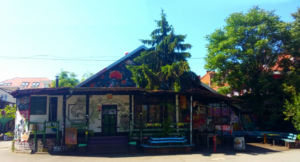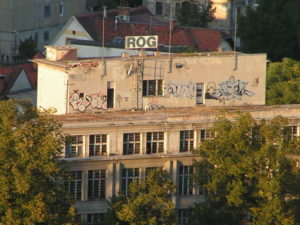
Editor’s note: We publish this text in collaboration with the regional portal Bilten following last Saturday’s (27 August) aggressive attack on Akc Metelkova, the autonomous cultural and social center in Ljubljana, Slovenia, by an organised group of neo-nazis. According to the center’s statement “the attackers shouted out fascist slogans, started to throw rocks, bottles and fireworks, and then cowardly escaped. In consequence, they injured several people, and one needed to go to a hospital due to head injuries. When police arrived in Metelkova, they acted violently toward those that had in fact defended the onlookers from the violence of the neo-nazis.” From Akc Metelkova they go on to state “we understand this attack as a continuation of the politics of emergency and fear, through which the Government is spreading discord and hatred amongst the people, whilst in the background under the excuse of the austerity measures and crisis management, it ceaselessly ravages society.”
Simultaneous mass gatherings all over the country, including huge numbers of people protesting in small cities and villages, high rate of distrust in institutional politics, dispersed mobilization through social media. In the winter of 2012/2013 those were some of the characteristics of mass protests, called the uprising, that were in many ways open, anti-authoritarian and even anti-capitalist, and have contributed to the fall of the right wing prime minister Janez Janša and his government. In the winter of 2016, in the midst of what the authorities dubbed “The migrant crisis”, those were the characteristics of the wave of protest that almost turned into the biggest right-wing uprising Slovenia has ever seen, and was highly supported by the same political party that had once fallen due to public pressure.
At the same time as the image of fascism is changing from organized small neo-Nazi groups into more mainstream patriotic streams, we are also seeing the radicalization into increased militancy among old and new organized fascists. What has changed and what could be the potential answers to the new form of fascism in Slovenia and beyond?
The spirit of time – background story
Organized politics of hate, coming both from institutional political parties and organized neo-Nazi groups is nothing new in Slovenia and has been an integral part of the transition from socialism to capitalism. In terms of organized neo-Nazi groups, Slovenia has seen their rise since the 1990’s, with their politics ranging from closed concert activities to open public attacks on anti-authoritarian, anti-capitalist and anti-racist people, organizations and structures. Many of these attacks went unnoticed or were characterized as street violence, though some gained more attention , such as the neo-Nazi skinhead attacks in 2001 against a person of color, and in 2009 against the LGBT bar and a journalist in Ljubljana.
Despite ever present attempts (since the late 1980’s) from the right wing spectrum of institutional politics to create a patriotic relation towards the newly born Slovenian state and its symbols, patriotism was not a clear public choice for most people. Slowly that began to change through mass sport, numerous border related conflicts with Croatia in the 2000’s and the slow penetration of such topics in the public sphere, in schools and even kindergartens. That slowly contributed to the rise of several patriotic organizations, that are less radical in their public image: from actions they take on the streets, to their public appearance and clothing and especially in terms of the positions they hold. Consequently, they are recruiting a much wider population, especially among young people. Their politics of hate is similar to those we are used to hearing from neo-Nazi groups, but it has began to take a much more publicly acceptable form, as such organizations have slowly become the legitimate partners in public discourse, running for official positions, and participating in mainstream media.
In 2009 patriotic groups tried to intensify anti-Muslim hatred and attempted to organize a protest against the building of the first mosque in Ljubljana, but were stopped by the wide Anti-fascist front activities, that included a huge number of different actors, struggling for open and tolerant city. At the same time we have been witnessing self organized hate from below, most notably in 2006, when villagers of Ambrus (and then some other places as well) organized into a mob, who chased the Roma family Strojan into the woods and out of their village with proper pogrom.
Despite the fact journalists have widely reported on the connections between the biggest right-wing political parties and members of organized neo-Nazi groups, it is important not to draw conclusions based on conspiracy theories. Organized hate on the streets of Slovenia is mostly working autonomously, but it is definitely being encouraged by the general spirit of the time in institutional political environment, where politicians from the right wing have consistently for decades been building their politics on the agenda against LGBTQ community (preventing adoptions, marriages etc.), Roma, migrants, etc.
Closing Slovenia for migrants, opening it for the politics of hate

In the fall of 2015, when officials from the European union declared state of emergency in the Balkans due to the increased migration flow, Slovenia became the central figure in narrating the closing of the so-called Balkan route. As soon as Hungary closed down the borders, Slovenia became the main transit point, and also the second country in Europe to close down its southern border with barbed wire, encouraging its neighbors in former Yugoslavia to shut down the transport of migrants as well. This was orchestrated by a Slovenian political party, which won the election campaigning on the agenda of rule of law, human rights and centrist politics. As soon as the so called crisis started, they adopted the discourse of security and fear, disciplining mostly the inner population through the creation of an outside enemy in the image of the Other, a migrant. They have actively contributed to the situation that opened up a space for more open hate rhetoric and actions from both right-wing political parties, organized fascist and patriotic groups, to the more or less self-organized citizens, radicalized in anti-migrant discourse .
When in January and February 2016 the Slovenian government started to search for potential centers for refugees in smaller cities around the country, the above mentioned groups of society started to mobilize on social networks. Protests started to follow one after another in small places that never even saw protest activities before. 300 people in Kidričevo, 200 in Vrhnika, 300 in Lenart, 3.000 in Šenčur (total population 3.121) and many other places, all happening within less than three weeks. Despite the presence of established politicians from right wing parties, some payed and organized buses (we were able to see the insignia and faces from organized patriotic and fascist groups there too), majority of these people were self-organized.

Around the same period we have seen increased militant presence of fascist groups on the streets, several attacks on the autonomous squat Sokolski dom in Novo mesto, including with Molotov cocktail, where people were gathering food and clothes for refugees, graffiti in Ljubljana, calling for rape of leftist women (because they are supporting migrants), and later on (in July 2016), organized mass neo-Nazi attack on the Autonomous Factory Rog, one of the rare places in Ljubljana, where migrants are self organizing and are welcome to spend their time and organize activities there (though the attack itself was highly connected with attempted eviction of Rog as well.
Resisting politics of hate
As we have already seen in 2009, the momentum for right-wing public activities in 2016 was once again stopped by anti-fascist protests, when both, the Anti-racist Front and right wingers organized protests in the same street in front of the asylum home in the end of February 2016 in Ljubljana. Antifascist protest drew more people to the streets, from activists to cultural workers and migrants themselves, whereas the right wing protest included everyone, from “concerned” elderly citizens to neo-Nazis, mobilized through social media, with patriotic anti-migrant rhetoric.
In the aftermath, on the one hand we have seen public support to stop the rise of fascist politics in Slovenia; on the other hand we have seen parliamentarians once again discussing left-wing militancy and extremism. The response of the institutional left was then to accept this game of two opposing extremes and instead of talking about open and inclusive society, they participated in discussion about extremism in Slovenia, trying to expose the one from the right wing. Strengthening anti-extremism laws is a common agenda in Slovenia and Europe, often resulting in stricter laws that gives police more jurisdiction in monitoring social movements from below, regularly resulting in terrorist cases against anarchist and rarely, if ever, in any kind of cases against right wing extremism against who they are suppose to be aimed.
However, the fact remains that last year has marked the biggest rise not only of right wing rhetoric, but also the composition and militancy of fascist groups we have seen so far, and this has not been fully handled with from the side of the movements as well. Just like in the rest of Europe, where anti-migrant and anti-Muslim sentiments are reviving the right wing scene in institutional politics and on the streets, we are seeing the same thing happening in Slovenia as well. We are no longer dealing with (merely) classical neo-Nazi groups nor right wing politicians. In the past answers from the institutional Left were simple. They tried to elect left wing parties to power, unifying resistance to fascism under the realm of the state and in context of criminalization. For a while this was perhaps a semi-successful tactic for those who hold privileges (light skin, male gender, official documents), whereas people, who are pushed to the edges of our societies have continued to be targeted by fascist violence. Today, in the aftermath of economic crisis, the politics of hate is spreading through a new spectrum of society, where young mothers, our neighbors, schoolmates and teachers are marching along neo-Nazis under the patriotic flags and slogans they need to protect their authentic culture. The genie is out of the bottle and institutional politics have no answer to this.
Just like in the rest of Europe, the new face of fascism is starting to create a situation, in which they are trying to preserve Slovenia as a gated community of privilege. They are similarly using the language of ownership to justify their ideas. The Slovenian government first claimed their territory – building a wire fence to protect the borders. Their counterparts in right wing political parties and patriotic groups introduced the idea of their role in production of goods and social relations, being endangered by the Other, by migrants allegedly wanting to take their jobs, women, culture, values. They are putting themselves to positions of authority, that is determining reality for everyone in Slovenia. Hence, the main struggle against such authoritarian politics of hate, that is not coming from a focal point of few neo-Nazi groups or even right-wing political parties, can only be countered by dispersed anti-authoritarian struggle from below.
The question for such movements, who have not yet proven to be entirely successful, however, is how to demonstrate what it means to fight the rise of fascism in society? How to develop tactics and open political space in which people, who are not prone to the politics of hate, yet lack the co-speakers to step up against it, can find each other? This is even more pressing in a situation, where left-wing movement’s tactics, as we have seen in Slovenia, can easily be re-appropriated by the self organizing fascist mobs as well. The task therefore is also a struggle for ideas, principles, and concrete political content of anti-authoritarian open politics that would mobilize against growing hate in our societies.

Tjaša Pureber is a political scientist, researcher of social movements and journalist from Ljubljana, Slovenia.

